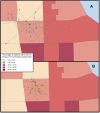Geospatial Imprecision With Constraints for Precision Public Health: Algorithm Development and Validation
- PMID: 38772021
- PMCID: PMC11150894
- DOI: 10.2196/54958
Geospatial Imprecision With Constraints for Precision Public Health: Algorithm Development and Validation
Abstract
Background: Location and environmental social determinants of health are increasingly important factors in both an individual's health and the monitoring of community-level public health issues.
Objective: We aimed to measure the extent to which location obfuscation techniques, designed to protect an individual's privacy, can unintentionally shift geographical coordinates into neighborhoods with significantly different socioeconomic demographics, which limits the precision of findings for public health stakeholders.
Methods: Point obfuscation techniques intentionally blur geographic coordinates to conceal the original location. The pinwheel obfuscation method is an existing technique in which a point is moved along a pinwheel-like path given a randomly chosen angle and a maximum radius; we evaluate the impact of this technique using 2 data sets by comparing the demographics of the original point and the resulting shifted point by cross-referencing data from the United States Census Bureau.
Results: Using poverty measures showed that points from regions of low poverty may be shifted to regions of high poverty; similarly, points in regions with high poverty may be shifted into regions of low poverty. We varied the maximum allowable obfuscation radius; the mean difference in poverty rate before and after obfuscation ranged from 6.5% to 11.7%. Additionally, obfuscation inadvertently caused false hot spots for deaths by suicide in Cook County, Illinois.
Conclusions: Privacy concerns require patient locations to be imprecise to protect against risk of identification; precision public health requires accuracy. We propose a modified obfuscation technique that is constrained to generate a new point within a specified census-designated region to preserve both privacy and analytical accuracy by avoiding demographic shifts.
Keywords: confidentiality; geocoding; geographic; geography; geospatial; location; locations; low income; obfuscation; poverty; precision; privacy; security; social determinants of health; spatial.
©Daniel Harris, Chris Delcher. Originally published in the Online Journal of Public Health Informatics (https://ojphi.jmir.org/), 21.05.2024.
Conflict of interest statement
Conflicts of Interest: None declared.
Figures



References
-
- Wang F. Why public health needs GIS: a methodological overview. Ann GIS. 2020;26(1):1–12. doi: 10.1080/19475683.2019.1702099. https://europepmc.org/abstract/MED/32547679 - DOI - PMC - PubMed
-
- Pearson J, Jacobson C, Ugochukwu N, Asare E, Kan K, Pace N, Han J, Wan N, Schonberger R, Andreae M. Geospatial analysis of patients' social determinants of health for health systems science and disparity research. Int Anesthesiol Clin. 2023 Jan 01;61(1):49–62. doi: 10.1097/AIA.0000000000000389. https://europepmc.org/abstract/MED/36480649 00004311-202306110-00008 - DOI - PMC - PubMed
-
- Dally D, Amith M, Mauldin RL, Thomas L, Dang Y, Tao C. A semantic approach to describe social and economic characteristics that impact health outcomes (social determinants of health): ontology development study. Online J Public Health Inform. 2024 Mar 13;16:e52845. doi: 10.2196/52845. https://ojphi.jmir.org/2024//e52845/ v16i1e52845 - DOI - PMC - PubMed
-
- Hussein M, Diez Roux AV, Field RI. Neighborhood socioeconomic status and primary health care: usual points of access and temporal trends in a major US urban area. J Urban Health. 2016 Dec;93(6):1027–1045. doi: 10.1007/s11524-016-0085-2. https://europepmc.org/abstract/MED/27718048 10.1007/s11524-016-0085-2 - DOI - PMC - PubMed
-
- Mohnen SM, Schneider S, Droomers M. Neighborhood characteristics as determinants of healthcare utilization - a theoretical model. Health Econ Rev. 2019 Mar 06;9(1):7. doi: 10.1186/s13561-019-0226-x. https://europepmc.org/abstract/MED/30840211 10.1186/s13561-019-0226-x - DOI - PMC - PubMed
Grants and funding
LinkOut - more resources
Full Text Sources

